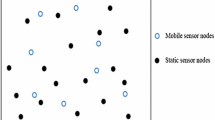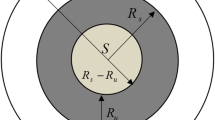Abstract
Wireless sensors networks (WSNs) have be applied to a number of fields such as environment monitoring, military surveillance, data collection and etc. However, the coverage holes problem are usually caused by some undesirable reasons, such as random deployment of sensors, energy consumption imbalance, unethical attack and hardware failures. The holes affect capabilities of WSNs greatly, so its recovery is one of the pivotal problems in WSNs. In order to enhance the performance of holes recovery, a robust approach based on an improved artificial fish swarm algorithm is presented in this paper. The movement of mobile nodes is analogized to the motion of artificial fish with the network coverage rate as objective function. Besides the classic artificial fish motion such as prey, follow and swarm, two novel fish motions called as leap and rebirth are also presented to enhance the convergence of this algorithm. An approach of self-adaptive visual range and step length for fish motion are adopted when updating the status of artificial fish. Simulation experiments show the effectiveness and robustness of the algorithm. The holes can be recovered efficiently without location information and holes detection using the least amount of mobile nodes. The network coverage is improved significantly with this proposed algorithm.









Similar content being viewed by others
References
S. Mishra, R. Bano, S. Kumar, et al., A literature survey on routing protocol in wireless sensor network. In: 2017 IEEE 4th International Conference on Knowledge-Based Engineering and Innovation (KBEI), IEEE, pp. 0373–0378, 2017.
J. Wang, C. W. Ju, H. Kim, et al., A mobile assisted coverage hole patching scheme based on particle swarm optimization for WSNs, Cluster Computing, 2017. https://doi.org/10.1007/s10586-017-1586-9. (Published Online, 2017).
C. X. Qiu, H. Y. Shen and K. Chen, An energy-efficient and distributed cooperation mechanism for k-coverage hole detection and healing in WSNs, IEEE Transactions on Mobile Computing, Vol. 17, No. 6, pp. 1247–1259, 2018.
W. Li and W. Zhang, Coverage hole and boundary nodes detection in wireless sensor networks, Journal of Network and Computer Applications, Vol. 48, pp. 35–43, 2015.
L. H. Zhao, W. Y. Liu, H. W. Lei, et al., Detecting boundary nodes and coverage holes in wireless sensor networks, Mobile Information Systems, Vol. 2016, pp. 1–16, 2016.
F. Yan, A. Vergne, P. Martins, et al., Homology-based distributed coverage hole detection in wireless sensor networks, IEEE/ACM Transactions on Networking, Vol. 23, No. 6, pp. 1705–1718, 2015.
M. R. Senouci, A. Mellouk, K. Asnoune, et al., Movement-assisted sensor deployment algorithms: a survey and taxonomy, IEEE Communication Surveys & Tutorials, Vol. 17, No. 4, pp. 2493–2510, 2015.
P. F. Xu, Z. G. Chen and X. H. Deng, Distributed voronoi coverage algorithm in wireless sensor networks, Journal on Communication, Vol. 31, No. 8, pp. 25–34, 2010.
L. X. Deng, X. Ma, J. Gu, et al., Detection and repair of coverage holes in mobile sensor networks using sub-voronoi cells, International Journal of Robotics and Automation, Vol. 33, No. 6, pp. 601–610, 2018.
Q. Yu, W. D. Wan, L. J. Li, Improved recovery algorithm of coverage holes in hybrid WSN, Journal of University of Electronic Science and Technology of China, Vol. 46, No. 4, pp. 534–539,599, 2017.
K. Yang, Q. Liu, S. Zhang, et al., Hole recovery algorithm based on mobile inner nodes in wireless sensor networks, Journal on Communication, Vol. 33, No. 9, pp. 116–117, 2012.
H. Su and Y. Wang, A self-healing algorithm without location in sensor networks, Chinese Journal of Computers, Vol. 32, No. 10, pp. 1957–1970, 2009.
M. R. Senouci, A. Mellouk and K. Assnoune, Localized movement-assisted sensor deployment algorithm for hole detection and healing, IEEE Transactions on Parallel Distributed Systems, Vol. 25, No. 5, pp. 1267–1277, 2014.
W. Li and Y. W. Wu, Tree-based coverage hole detection and healing method in wireless sensor networks, Computer Networks, Vol. 103, pp. 33–43, 2016.
A. M. Khedr, W. Osamy and A. Salim, Distributed coverage hole detection and recovery scheme for heterogeneous wireless sensor networks, Computer Communications, Vol. 124, pp. 61–75, 2018.
R. Kadu, K. Malpe, Movement-assisted coverage improvement approach for hole healing in wireless sensor networks. In Proceedings of the 2017 2nd IEEE International Conference on Electrical, Computer and Communication Technologies (ICECCT), IEEE, pp. 1–4, 2017.
Y. M. Zhuang, C. D. Wu, Y. Z. Zhang, A coverage hole recovery algorithm for wireless sensor networks based on cuckoo search. In the 7th Annual IEEE International conference on Cyber Technology in Automation, Control and Intelligent Systems (CYBER), IEEE, pp. 1552–1557, 2017.
J. Wang, C. W. Ju, H. Kim, et al., A PSO based coverage hole patching scheme for WSNs. In International Conference on Computer Science and its Applications (CSA), pp. 433–439. Springer, 2018.
W. H. Liao, Y. C. Kao and Y. S. Li, A sensor deployment approach using glowworm swarm optimization algorithm in wireless sensor networks, Expert Systems with Applications, Vol. 38, No. 10, pp. 12180–12188, 2011.
Z. J. Han, X. M. Wen, Zheng W.: Artificial intelligence based handoff management for dense WLANs: a deep learning approach. In Proceedings of 2018 IEEE Globecom Workshops (GC Wkshps), IEEE, 2018.
O. A. Wahab, H. Otrok and A. Mourad, QoS-based clustering protocol for vehicular ad hoc networks, Computer Communications, Vol. 36, No. 13, pp. 1422–1435, 2013.
A. Soundarya, V. Santhi, An efficient algorithm for coverage hole detection and healing in wireless sensor networks. In 2017 1st International Conference on Electronics, Materials Engineering and Nano-Technology (IEMENTTech), IEEE, pp. 1–5, 2017.
X. L. Li, Z. J. Shao and J. X. Qian, An optimizing method based on autonomous animats: fish swarm algorithm, Systems Engineering Theory & Practice, Vol. 11, pp. 32–38, 2002.
L. M. Wang, F. Li and Y. Qin, Resilient method for recovering coverage holes of wireless sensor networks by using mobile nodes, Journal on Communications, Vol. 32, No. 4, pp. 1–8, 2011.
Acknowledgements
The work of this paper is sponsored by the National Natural Science Foundation of China (No. 61271143) and the Key Science and Research Project of Henan Province University of China (No. 20A520023).
Author information
Authors and Affiliations
Corresponding author
Additional information
Publisher's Note
Springer Nature remains neutral with regard to jurisdictional claims in published maps and institutional affiliations.
Rights and permissions
About this article
Cite this article
Yan, L., He, Y. & Huangfu, Z. A Fish Swarm Inspired Holes Recovery Algorithm for Wireless Sensor Networks. Int J Wireless Inf Networks 27, 89–101 (2020). https://doi.org/10.1007/s10776-019-00466-3
Received:
Revised:
Accepted:
Published:
Issue Date:
DOI: https://doi.org/10.1007/s10776-019-00466-3




